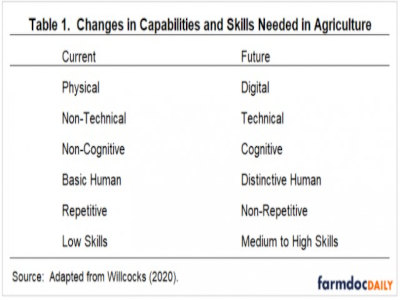The emergence of precision farming and in particular automation technologies is rapidly changing the nature of work for all businesses, including farms and ranches. To maintain a competitive advantage, farm operators will need to take a more active role in identifying the capabilities and skills needed by the business, and to develop mechanisms to recruit, train, and retain employees. As part of a skill assessment, it is important to identify “gaps in capabilities and skills” and to determine how the business is going to address these gaps. The discussion below will first discuss potential gaps in capabilities and skills and then pose some potential responses to these gaps.
As noted by Manyika et al. (2017) and Willcocks (2020), automation could perform certain tasks at medium to high performance. For example, general equipment and navigation, inspecting and monitoring, basic data input and processing, and basic communication could be performed relatively well with automation technologies. However, capabilities pertaining to creativity, leadership, complex information processing and interpretation, and advanced IT skills and programming would be difficult to emulate with automation technologies. In particular, tacit knowing or the fact that humans know more than they can describe is problematic to automation (Polanyi, 2009). Obviously, tacit knowledge makes it difficult to write code for machine learning.
Table 1 illustrates current capabilities and skills with potential future skills needed in production agriculture. This table was adapted from Willcocks (2020). To summarize the table, skills related to those that are difficult for machines to emulate (e.g., creativity, leadership, strategic positioning, and interpretation of data and information from precision agriculture technologies) will be critical to the farms in the future. Individual farms need to assess whether they have someone on board that has these capabilities and skills. If they don’t, would it be possible to contract for these skills? More options related to developing the workforce of the future are discussed below. From a time management standpoint, one of the upsides of current trends in automation is that it may free up employees to spend more time on their distinctive human capabilities and skills (e.g., interpretation of data and information from precision agriculture technologies) rather than on predictable physical work, potentially augmenting labor productivity.

In addition to discussing changes in skills needed in the workforce as businesses adopt automation technologies, Bughin et al. (2018) describe potential changes in the business workforce environment and options for companies to build the workforce of the future. Though the authors focus their discussion on businesses with numerous employees, many of the concepts discussed also apply to small businesses. In terms of the workforce environment, developing a mindset of life-long learning, stressing collaboration, and making sure that we have personnel that are responsible for leadership tasks, for supervising and training employees, and for developing a strategy to purchase and fully utilize precision agriculture technologies is important. Options for building the workforce of the future include retraining current employees, redeploying employees so that they can focus on future skills needed, hiring individuals with specific automation skills, contracting with outside parties for a portion of the automation skills needed, and removing skills that are not as pertinent as they have been historically. Even with a small workforce, farms will likely use a combination of these options rather than just one of the options.
We would be remiss if we did not indicate that there is going to be substantial competition for individuals with distinctive human capabilities and skills. Having these individuals in place or making sure that one of the operators or employees has the necessary skills set is likely to be critical to a farm’s competitive advantage. Thus, developing a plan to develop or obtain these skills from an outside party is very important.
Concluding Comments
This article discussed the capabilities and skills that will be needed to manage the farm of the future. As we have noted, production agriculture is changing very rapidly. Adopting precision farming and automation technologies (e.g., robotics, drones, autonomous machines) will be critical to a farm’s competitive advantage. Each farm needs to evaluate whether it has the workforce in place to take full advantage of precision agriculture and automation technologies, or develop a plan to access these capabilities and skills from an outside party.
Source : illinois.edu